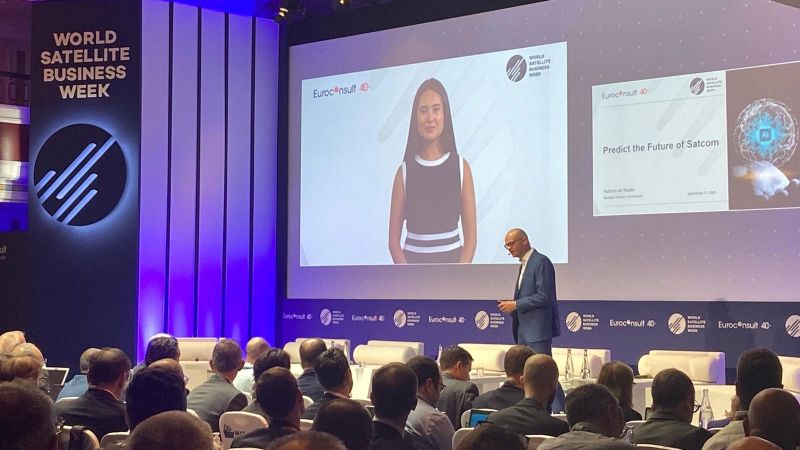Worlrd Satellite Business Week Highlight the Key Role of NGSOs
by Elisabeth Tweedie
Paris, France, October 1, 2023--Held in Paris as always, the 26th annual World Satellite Business Week (WSBW) attracted a record number of attendees: 1,500 from 50 different countries. Unusually, Nathan de Ruiter, Managing Director, Euroconsult opened his presentation jointly with Elona, a digital assistant, who explained that Artificial Intelligence (AI) holds the key to reshaping the communications landscape, particularly with regard to network management, by predicting network congestion and dynamically allocating resources.
In addition, according to Elona, it can also facilitate the autonomous operation of satellites and ground systems, as well as offering personalized service offerings to users. Interestingly, during the rest of the conference, there was not much discussion about AI and its impact, although Patrick Thera, President, Advanced Technologies, Calian mentioned that they were using AI for early detection of anomalies.
One of the key takeaways from this opening presentation, was the continuing gap between supply and demand, and the consequent downward pressure on pricing. By 2028 total capacity is forecast to be 195 Tbps, most of which, of course, comes from the Non-Geostationary Orbit (NGSO) constellations. By 2032 total demand is predicted to be 51 Tbps, so it’s hardly surprising that a 50% decline in prices is also being forecast. Total satcom revenue is forecast to grow from US$ 107 Billion to US$123 Bil. in the ten years to 2032. Interestingly, although video revenues are expected to decline by 15%, they will still account for nearly 60% of revenue in 2032, and in the last year, Eutelsat has launched two more satellites to serve this market.
 |
| Nathan de Ruiter, Managing Director, Euroconsult opened his presentation jointly with Elona, a digital assistant, who explained that Artificial Intelligence (AI) holds the key to reshaping the communications landscape. |
de Ruiter, did not specifically reference the media sector in conjunction with Starlink, but at IBC in Amsterdam, several, of the very few mentions of satellite, related to Starlink, or Low-Earth Orbit (LEO) constellations in general. Kevin Fernandes, CRO, Dejero stating that “At IBC we’re focusing our attention on 4k/UHD transmission from the field for remote production and contribution, utilizing the more recently deployed IP networks, such as 5G, Starlink and other LEO satellites to create resilient connectivity.”
In complete contrast to AI, Starlink featured in many panels at WSBW, even when it wasn’t on the agenda; which, given its impact on the industry in the last year, is hardly surprising. 66% of the 2.040 satellites launched in the first eight months of this year, were Starlink satellites. Comments ranged from the downright hostile, exemplified by John Finney, Founder and CEO All.Space, who asked during a panel on Smart Antennas, “Is there anyone from Starlink in the room?” When no hands were raised, he went on to comment: “That is what vertical integration is. You see, they don’t care about us and they don’t care about you. They would wipe out this industry if they could, without a second thought. This is reality.”
Others expressed admiration for what the company has achieved. With the caveat, that there are no published subscriber numbers, Euroconsult is forecasting that Starlink will have two million residential users by the end of this year, double the number it had at the end of 2022. A similar growth trajectory is forecast for business users, with Euroconsult predicting ~320,000 users by year end. However, it is in the maritime sector where the most growth is occurring, much to everyone’s, including Euroconsult’s surprise, given that there is currently no committed information rate (CIR) offering. At the end of last year, there were 500 vessels using Starlink. Growth has been phenomenal and Euroconsult is forecasting a seven-fold increase to 3,500 by year end. Factors contributing to this growth include, good data rates, low prices, and no data cap and a self-install antenna. The latter is particularly important for the maritime market. With SES’ surprise announcement, that it will be working with Starlink to deliver a managed service to cruise lines incorporating its MEO service, SES Cruise mPOWER, and Starlink’s LEO offering, this growth is likely to accelerate, as the combined managed service facilitates offering a CIR to users. Two service levels will be offered, 3 Gbps and 1.5 Gbps.
Starlink, were not only in the room, they were on-stage for the”NGSO Broadband Constellations, Keystones to Global Connectivity” panel and Jonathan Hofeller, VP of Starlink and Commercial Sales, talked about how the company has pivoted its business model in the last year. Initially, it managed the entire value chain, selling directly to customers. This was facilitated by the fact that the antennas are self-install. Then, in recognition of the fact that after-sales service and support is often needed, it started working with resellers, which Hofeller described as “an eye-opening experience.” This is causing channel conflict in some places, a fact that has been recognized and is being “worked on.” He went on to describe Starlink as an extremely “nimble” company, which can make it hard for partners who don’t move at the same pace. He quoted an example of discussing an issue on Friday and implementing a new policy to address the issue on Monday morning.
OneWeb, has adopted a policy of being a wholesaler and working with resellers from inception. Massilimiano Ladovaz, CTO, OneWeb commenting that “we do not wish to take business away from customers.” He also referenced the fact that the reality is, that it is now a multi-orbit world, which given its merger with Eutelsat, is pretty much a given for the company!
One of the opening keynotes was given by Doreen Bogdan-Martin, Director General, ITU, her comments were very encouraging for our industry: “ We truly believe that satellite connectivity holds the promise of increasing global digital inclusion, something central to the ITU’s mission. A mix of technologies is needed, but satellite broadband is sometimes the only option, so it can be a game changer.” One of the caveats, which is well known in the industry, is that many of the people who are currently not connected, cannot afford to connect. She commented that in Africa some people were paying 15% of their gross income to access fixed broadband. The ITU goal is that the maximum anyone should pay, is 2% of gross income.
Good news for US companies looking for financing was given by Judith Pryor, First VP & Vice Chair Board of Directors, Export-Import Bank of United States (EXIM), who stated very clearly, that EXIM was back, was not dysfunctional (as it has been described in the past) and is currently only financing US$35B of its $135B lending cap. This was greeted with enthusiasm, exemplified by Jonathan Baliff, CFO, Redwire, who stated: “The greatest thing to come out of this conference is that EXIM is back!”
The issue of cooperation and partnerships was raised in several panels, summed up by Peter Cannito, Chairman & CEO, Redwire: “If you want to go fast, go alone, if you want to go far, go together.” Of the three big new NGSO operators, only OneWeb chose to work with others to build its satellites, both Starlink and Amazon’s Kuiper designed and are building the satellites in-house. (The satellites for Lightspeed from Telesat, will be built by MDA). Starlink, originally started by controlling the entire value chain, and selling directly to the end user, but as already mentioned, reversed that policy, and now works with resellers. OneWeb has always been clear that it is a wholesaler. Naveen Kachroo, Director, Project Kuiper (Amazon) stated “We will work in every region to find the right combination of partner and our expertise for that particular market.” It already has a partnership with Vodafone for backhaul in Africa. Interestingly, OneWeb is also working with Amazon web services (AWS), even though Project Kuiper will be a competitor.
Eutelsat’s merger with OneWeb and ViaSat’s acquisition of Inmarsat, clearly show that the established operators certainly see the value in partnerships, as does SES’ decision to work with Starlink. David Wajsgras, CEO Intelsat stated, “Any company that thinks it can fly solo is delusional, it’s all about partnering.” Given all the changes going on at present, it will be very interesting to see which companies have merged and which companies are working together by this time next year.
-------------------
 Elisabeth Tweedie is Associate Editor of the Satellite Executive Briefing. She has over 20 years experience at the cutting edge of new commmunications entertainment technologies. She can be reached at: elisabeth@satellitemarkets.com
Elisabeth Tweedie is Associate Editor of the Satellite Executive Briefing. She has over 20 years experience at the cutting edge of new commmunications entertainment technologies. She can be reached at: elisabeth@satellitemarkets.com





